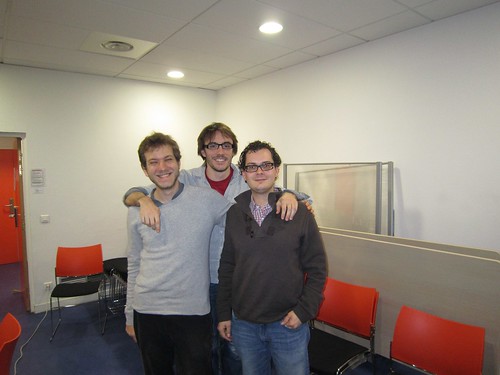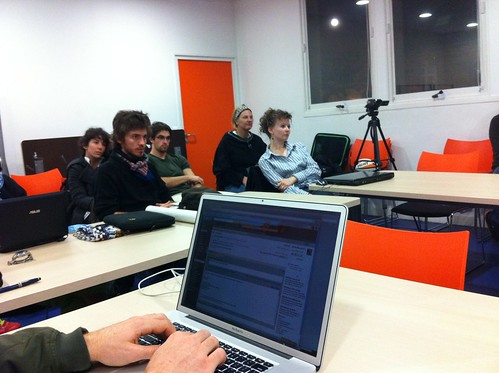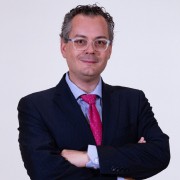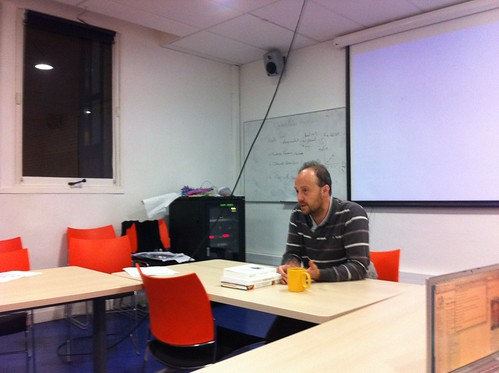Article published in the web of the CRI: Esteban Romero’s visiting guest at the CRI (sept-dec 2011)
This is the summary of the most remarkable activities I carried out at the Centre de Recherches Interdisciplinaires (CRI; @CRI_FdV_AIV) during my 3 months visit (September 15th – December 15th).

A) I gave a seminar titled “How to create a knowledge ecosystem using digital tools” (December 6th).
B) I participated in two courses: Open Science and Scientific Discovery Games. In the Open Science course I discussed some ideas to introduce the topic in one of the first sessions (see the article: “Open Science: an introduction to achievements and challenges“).
- “Open Science”. Working group description: “The digitalization of science affects the way it is done, the way it shared, the way we collaborate or are evaluated. Topics to be discussed include: creative commons (under which license should you protect your creation in different domains), open access to scientific publications and data, crowd sourcing project (for computing such as BOINC or data classification such as galaxy zoo), open source software, open source hardware (eg arduino), open wetware, etc.
- “Scientific Discovery Games”. Working group description: “The success of gamers in games such as Fold.it are each year more impressive. Last year in Nature they announced that players can make better predictions than the best software. This year the gamers in 2 weeks solve a problem where scientists had failed for 15 years. Gamers are even able to propose new heuristics for solving problems.”
C) I attended regularly the meeting organised by two scientific clubs at the CRI: Fabelier and Learnit L

Fabelier
Fabelier (@fabelier) is “a *Lab to create new things”. It belongs to the Hackerspaces.org network. The lab is hosted and sponsored by the CRI in the AIW Web Science Master spinneret of AIV. Activities:
- Sylvain Zimmer and Michel Levy Provencal presented Joshfire (@joshfire; September 28th). Joshfire is “an open source multi-device framework based on web technology. Develop only one application. Reach the web, mobile devices, tablets and smart TVs, as well as connected objects. Using only standards like HTML5 and JavaScript, it allows developers and integrators to quickly create native and dedicated web apps for browsers, Node.JS, desktops, smart phones, smartTVs and connected objects.”
- Dominique Sciamma (slideshare), head of research at Strate College, introduced the Design and his experience in interdisciplinarity (October 19th). The meeting was oriented to build common links between StrateCollege students and CRI’s students in order to build projects together.
- Jeff Clune (November 9th) introduced the project EndlessForms (@EndlessFormsCom) in a talk titled “Evolving robot morphologies and neural networks with abstractions of biological developments”. The author is a Postdoctoral Fellow in Hod Lipson’s lab at Cornell University, funded by a Postdoctoral Research Fellowship in Biology from the National Science Foundation. He studies generative encodings, which enhance evolutionary algorithms by augmenting them with concepts from developmental biology. Author’s description of the talk: “I will describe my work with an algorithm that combines evolution with developmental biology to automatically produce complex designs. This algorithm enables the generation of complex, regular phenotypes, such as three-dimensional objects and artificial neural networks to control robots. The evolved morphologies and neural networks exhibit desirable properties found in their natural counterparts, such as symmetries and repeated motifs. I will also describe a project that combines this algorithm with crowdsourcing to allow internet users to collectively explore the evolutionary design space. At EndlessForms.com, visitors individually direct evolutionary processes similar to how breeders evolve roses or dogs. Collectively, visitors have evaluated over 2.4 million objects and have produced an interesting and diverse set of evolved objects.”
- Raphael Velt presented D3.js (December 7th). D3 is a JavaScript data library framework created by Mike Bostock at Stanford University as a successor to Protovis. “D3 stands for “Data-Driven Documents”, and relies on one major paradigm: binding data models to DOM elements (either HTML markups or SVG graphic elements). It provides functions to manipulate both sides of this bond, allowing data transformations as well as visual animations.”
- Nicolas Maisonneuve (December 14th): “Nicolas is acting in various areas as AI, Machine learning, crowdsourcing, human computation, modelisation, attention economy, etc. His work focus on many topics such as serendipity, augmented reality, voting systems, data empowerment, noise pollution, etc. Each time, going from some simple ideas to great, useful, innovative prototypes.” Project: Noisetube.
Learnit Lab
Learnit Lab (blog and reddit) is “a collaborative project between les Nouveaux Étudiants, Makesense and the CRI – The Center of Interdisciplinary Research. Learnit Lab is a center for workshops and idea making concerning empowering learners. Created by les nouveaux étudiants (The new students) movement and the CRI (The center for interdisciplinary research). We want to achieve this by providing a physical as well as a virtual space to meet, discuss, exchange resources, conduct workshops and lectures by some of the world’s most brilliant thinkers and creating a learning by doing community.” Who are behind the initiative apart from the CRI?
- The New Students association. They organise Edu’Hack’tion events. According to their website: “Edu’Hack’tion is a meet-up where students, teachers, citizens gather to imagine and test new ways of learning. Anyone can create an Edu’Hack’tion in his own school, university, city through the meetup everywhere for Edu’Hack’tion platform. They usually have two times : A creativity workshop to conceive solutions & A practical workshop to test them.
- Makesense: “We connect Social Entrepreneurs with supercool individuals ready to take up their challenges. Find a social entrepreneur, connect with him and finally solve his challenge.”
- Dale J. Stephens (@dalejstephens) presented Uncollege (October 5th).
- Simon Bachelier from Universcience talked about Serious Games (December 12th): “Serious games? Game-based learning? Games for change? Data Games? Scientific discovery games? Social Games? Gamification? Are we seriously talking about video games or are those new sort of games a “mature” evolution of a genre? Hardcore gamers argue there is no “true” gaming essence in serious games, while some teachers, parents and even some public institutions such as museums, schools or universities praise these new games as if they were THE learning tool of the century. What is behind this new generation of games? Simon is currently video game projects manager at Universcience (La Cité des sciences et de l’industrie) and a member of the indie game collectiv One Life Remains.”

D) I attended other meetings and conferences and had the opportunity to exchange views, ideas and projects with many scientifics, academics and practioners working in very different disciplines. For example:
- Pall Thayer presented Microcodes at la Gaité Lyrique (December 1st). Pall Thayer is “an Icelandic/American artist who works with computer programming code as an artistic medium. He studied visual arts at the Icelandic College of Arts and Crafts, the Helsinki Academy of Art and received his MFA in Open Media at Concordia University, Montreal in 2008. He has been active within the computer based art scene since the late 90’s. He has exhibited and presented his work at festivals and galleries around the world including New York, Montreal, Copenhagen and Sao Paulo. He currently works as a computer programmer and lecturer at SUNY Purchase College in New York. Computer programming code has mostly been regarded in a functional sense. Even as artists have moved into the realm of writing code to produce art, the code itself has been seen as a “tool” and not generally considered in an aesthetic or conceptually meaningful way. Pall Thayer will present some of his art work going back to the year 2006, using his piece as a point of departure to explain and examine the role of code in his work and why he later ended up producing “Microcodes“, works based entirely on displaying computer programming code as final art works as opposed to displaying the results of running that code.”
- Raffael Lomas (November 18th) is an artist and TED fellow. Raffael exposed his questioning as an artist and reflected together with the audience about creativity and the connections between art and science.
- Scientific Red Cards, a project “dedicated to taking inventory of scientific publications for which research misconduct has been assessed”.

